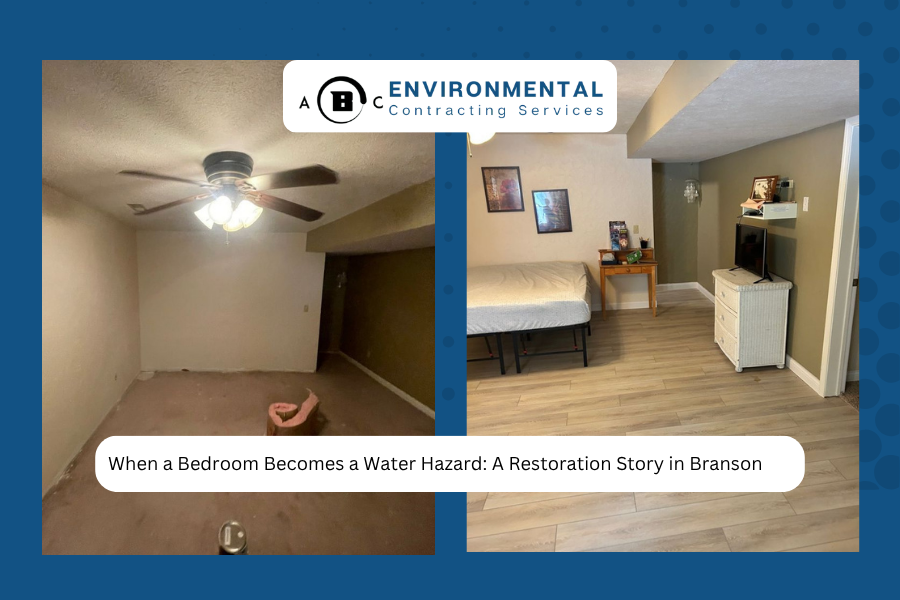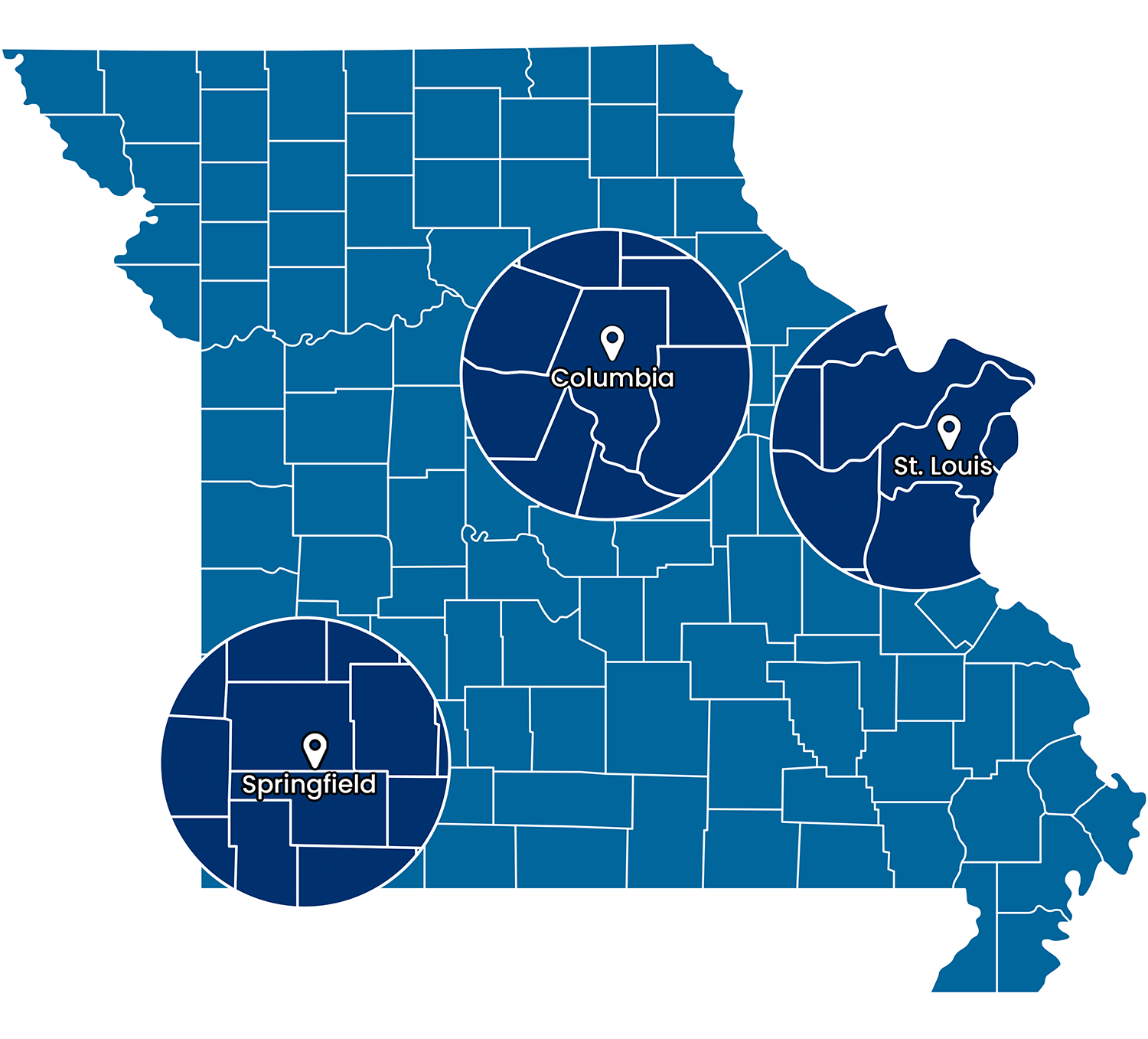
How to Winterize Pipes Before Freezing Weather Hits
Jump to Section:
Winter in Springfield can be unpredictable. One day it's 50 degrees, the next you're waking up to ice on the driveway and frozen pipes in your walls. At ABC Environmental Contracting Services in Springfield , we've seen what happens when pipes aren't properly protected, and trust us, it's not pretty. Burst pipes can cause serious water damage , and if water sits too long, you might even need mold remediation on top of everything else. The good news? A little prep work now can save you a whole lot of headache (and cash) later.
Let's walk through how to winterize your pipes so you can sleep soundly when the temperature drops.
Why Winterizing Your Pipes Matters
When water freezes, it expands. That's science class 101, right? But when that expansion happens inside your pipes, the pressure can cause them to crack or burst completely. And once a pipe bursts, you're not just dealing with a small leak. You're dealing with gallons of water flooding into your walls, ceilings, and floors. We've helped plenty of homeowners recover from situations like this utility closet flood in Nixa , where a burst pipe caused extensive damage throughout the home.

Proper pipe insulation and winterization can prevent costly burst pipe damage during Springfield's coldest months.
The reality is that frozen pipes are one of the most common winter disasters in the Ozarks. Between the overnight temperature swings and our older housing stock, homes around here are especially vulnerable. But winterizing your pipes doesn't have to be complicated or expensive. It just takes a little time and attention before the deep freeze sets in.
Locate Your Vulnerable Pipes
Not all pipes are at equal risk. The ones you really need to worry about are the ones exposed to cold air or located in unheated spaces. Here's where to look:
- Outdoor spigots and hose bibs: These are directly exposed to the elements and freeze first.
- Pipes in unheated areas: Basements, crawl spaces, attics, and garages often lack proper insulation.
- Exterior walls: Pipes running through exterior walls don't have as much protection from the cold.
- Under kitchen and bathroom sinks: Especially if they're on an outside wall.
Take a walk around your property and make note of where your pipes are most exposed. Those are your priority areas.
Critical Pipe Protection Zones
Click each zone to learn more about protecting vulnerable areas in your home:
🌡️ Outdoor Faucets
First to freeze. Disconnect hoses and shut off interior valves before the first freeze.
🏠 Crawl Spaces
Close vents in winter and insulate exposed pipes with foam sleeves.
🚿 Exterior Wall Pipes
Let faucets drip during extreme cold and keep cabinet doors open.
🔧 Unheated Spaces
Garages, attics, and basements need extra attention and insulation.
Step-by-Step Guide to Winterizing Your Pipes
Ready to get started? Here's your game plan for protecting your plumbing before the next cold snap.
Disconnect and Drain Outdoor Hoses
This one's easy but critical. Start by disconnecting all garden hoses from your outdoor faucets. Drain any remaining water from the hoses and store them inside for the winter. Even a little bit of water left in a hose can freeze, expand, and damage the faucet or the pipe behind it.
Once your hoses are put away, turn off the water supply to outdoor faucets from inside your home (if you have shut-off valves for them). Then open the outdoor faucet to let any remaining water drain out.
Insulate Exposed Pipes
Pipe insulation is cheap, easy to install, and incredibly effective. You can pick up foam pipe sleeves at any hardware store for just a few bucks. Simply slip them over exposed pipes in your basement, crawl space, attic, or garage. For extra protection in especially cold areas, you can wrap pipes with heat tape or heat cables , which are designed to keep pipes warm even in freezing conditions. Just be sure to follow the manufacturer's safety instructions carefully to avoid any fire hazards.

Foam pipe sleeves and heat tape provide affordable protection for exposed pipes in crawl spaces and basements.
Don't forget about pipes under sinks on exterior walls. You can insulate those too, or at a minimum, keep cabinet doors open during cold nights so warm air can circulate around them.
Seal Gaps and Cracks
Cold air can sneak into your home through the tiniest openings, and once it does, it goes straight for your pipes. Take some time to check around windows, doors, and where pipes enter your home. Use caulk or spray foam to seal up any gaps or cracks you find. This doesn't just protect your pipes, it also helps with your heating bill, so it's a win all around.
Need Help Protecting Your Home This Winter?
If you're worried about frozen pipes or just want peace of mind, our team at ABC Environmental Contracting Services in Springfield is here to help. We offer 24/7 emergency services, and we're always ready to respond fast when things go wrong.
Call Us at (417) 302-3010Let Faucets Drip During Extreme Cold
When temperatures are forecast to drop into the teens or lower, let your faucets drip slightly overnight. This keeps water moving through the pipes, which makes it much harder for ice to form. You don't need a full stream, just a slow, steady drip from both the hot and cold taps. Focus on faucets connected to pipes in vulnerable areas, like exterior walls or unheated spaces.
Yes, this uses a little extra water, but it's nothing compared to the cost of repairing a burst pipe and dealing with water damage.
Keep Your Home Warm
It might be tempting to turn down the thermostat when you're away to save on heating costs, but don't go too low. Keep your home at least 55 degrees, even when you're not there. This helps maintain a baseline temperature that keeps pipes from freezing.
If you're leaving town for an extended period during winter, ask a neighbor or friend to check on your house periodically. They can make sure the heat is still running and that everything looks okay. It's a small ask that can prevent a big disaster.
Consider Draining Your Plumbing System
If you have a vacation home or a property that will sit empty all winter, consider draining the entire plumbing system. This involves shutting off the main water supply, opening all faucets to drain the lines, and flushing toilets to empty the tanks. You may also want to add antifreeze (the non-toxic RV kind) to drains and toilet bowls to prevent any remaining water from freezing. This is a more advanced step, so if you're not comfortable doing it yourself, call in a professional.
What to Do If a Pipe Freezes
Even with all the right precautions, sometimes a pipe still freezes. If you turn on a faucet and only a trickle comes out, you likely have a frozen pipe. Here's what to do:
- Keep the faucet open. As the ice melts, water needs somewhere to go.
- Apply gentle heat. Use a hair dryer, heating pad, or warm towels to thaw the pipe. Start near the faucet and work your way back. Never use an open flame.
- Call for help if needed. If you can't locate the freeze or if a pipe has already burst, call ABC Environmental Contracting Services in Springfield right away.
We've handled plenty of storm-related water losses and frozen pipe emergencies, and we're ready to help you too.
Winterizing Checklist: Everything You Need to Do
Here's a quick recap to keep you on track:
| ✓ | Winterizing Task | When to Complete |
|---|---|---|
| Before first freeze | ||
| Before first freeze | ||
| Early winter | ||
| Before cold weather | ||
| When temps drop below 20°F | ||
| Throughout winter | ||
| During cold snaps | ||
| Before winter trips |
Frequently Asked Questions
Q: Should I disconnect my outdoor hoses even if I don't use them in winter?
A: Absolutely. Even if you haven't touched your hoses since fall, leaving them connected can trap water in the faucet and pipes behind it. That trapped water can freeze, expand, and crack the faucet or the pipe inside your wall. Always disconnect, drain, and store hoses before the first freeze.
Q: How long should I let my faucets drip during a cold snap?
A: Let them drip throughout the entire time temperatures are forecast to stay below 20°F. This is usually overnight, but during extended cold snaps in Springfield, you might need to keep them dripping for a day or two. A slow, steady drip from both hot and cold taps is all you need.
Q: If I have a basement, do I still need to worry about frozen pipes?
A: Yes, especially if your basement is unheated or if you have pipes running along exterior walls. Basements in the Ozarks can still get cold enough for pipes to freeze, particularly in older homes. Focus on insulating any exposed pipes and sealing gaps where cold air might sneak in.
Q: What should I do if I hear a pipe burst in my walls?
A: First, shut off your main water supply immediately to stop the flow. Then call ABC Environmental Contracting Services in Springfield at (417) 302-3010 right away. We offer 24/7 emergency response and can start water mitigation quickly to minimize damage to your home.
Final Thoughts
Winterizing your pipes is one of those tasks that's easy to put off until it's too late. But here's the thing, by the time temperatures drop into the danger zone, it's already too late. A few simple steps now can save you from a major headache later. And if you ever do run into trouble, you know who to call.
Stay warm out there, and if you need anything, we're just a phone call away at ABC Environmental Contracting Services in Springfield. We're here for you, 24/7, all winter long.





